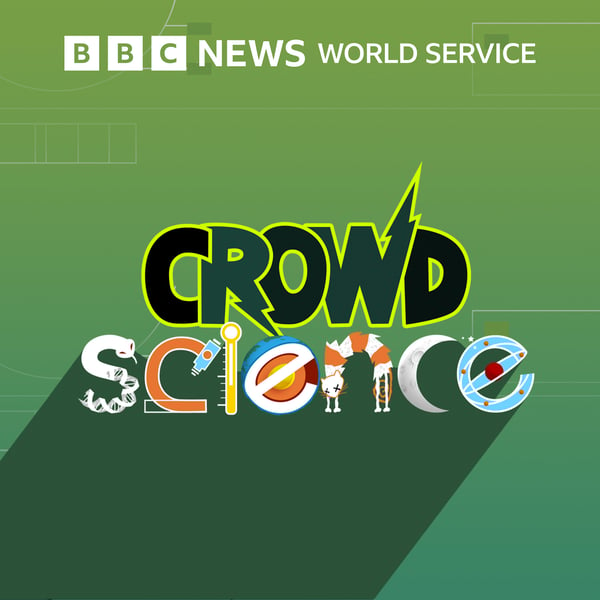Why isn't the sky green?
CrowdScience
BBC
4.8 • 985 Ratings
🗓️ 21 February 2025
⏱️ 28 minutes
🧾️ Download transcript
Summary
Vermillion red, vibrant orange, golden yellows, even violet – we're enchanted by the colours that make up a stunning sunset or sunrise. CrowdScience listener Paulina, a lighting designer from Chile, often uses the sunsets she sees from her balcony as inspiration for her designs. And during the day and night, the sky can be all sorts of shades of blue. But Paulina wonders why, in the colour palette of the sky, she never sees any green.
CrowdScience gazes skywards to investigate. Presenter Caroline Steel travels to the Arctic Circle to meet atmospheric physicist Katie Herlingshaw. Katie explains why we usually see the sky as blue, and what makes it transform into fiery reds and oranges at sunrise and sunset. We also peer into the science of perception, as neuroscientist Bevil Conway tells us what’s going on in our eyes (and brains) to make the colours we see in the sky.
But there are some rare occasions when the sky can appear to be green, such as in a rainbow or a green flash at sunset. And then there is the spellbinding green glow of the aurora - the Northern and Southern Lights. We visit the northernmost aurora observatory in the world to try to understand this phenomenon. Are green skies more common than we think?
Presenter: Caroline Steel Producer: Hannah Fisher Editor: Cathy Edwards Production Co-ordinator: Ishmael Soriano Studio Manager: Sarah Hockley
(Photo: View of sunset in Santiago, Chile. Photo montage courtesy of Paulina Villalobos)
Transcript
Click on a timestamp to play from that location
| 0:00.0 | Hello, you're about to listen to a BBC podcast, so I'd like to tell you where you'll find more just like it. |
| 0:05.5 | I'm Izzy Lee Poulton, an assistant commissioner for BBC Sounds, which means I'm involved in the whole podcast making process. |
| 0:12.0 | Whether that's developing fresh formats or facilitating eye-catching artwork, I helped project manage all the details that make our podcast stand out. |
| 0:19.0 | At the BBC, we've got access to |
| 0:21.4 | storytellers and experts across a huge range of subjects. It could be psychologists, comedians, |
| 0:27.2 | celebrities or journalists. No podcasts or day looks the same here. So no matter what you like, |
| 0:32.8 | check out BBC Sounds. There's probably another podcast on there that you're absolutely love. |
| 0:39.6 | So we're just like going up this last bit now to the, to the radars. |
| 0:45.3 | So we're taking everything out of the car because we're going in. |
| 0:47.7 | We're going to the belt wagon now, so I'm going to shove my suit on as well. |
| 0:52.4 | Okay, we're just jumping in beltwagon. |
| 0:55.0 | You're listening to Crowd Science from the BBC World Service. |
| 0:59.0 | I'm Caroline Steele and I'm with driver Fred, producer Hannah and physicist Katie. |
| 1:05.0 | We're in Svalbard, a group of islands in the Arctic Circle, in a belt wagon, |
| 1:12.6 | basically a cross between a minibus and an army tank, designed to drive over deep snow. |
| 1:22.6 | We arrive at a remote observatory in the hope of catching a glimpse of the northern lights. |
| 1:28.3 | I'm just sliding down some snow to get to get in on my bum. |
| 1:32.3 | Oh, oh, on my back. |
| 1:34.3 | It's cold and it's dark. |
| 1:37.3 | It's polar night in Svalbard, which means the sun doesn't rise past the horizon. |
| 1:42.3 | But there's a faint pinkish glow from a sunrise further south. |
| 1:48.4 | We'll return to our Arctic adventure soon. But first, we're heading much further south, to Chile, |
... |
Transcript will be available on the free plan in -22 days. Upgrade to see the full transcript now.
Disclaimer: The podcast and artwork embedded on this page are from BBC, and are the property of its owner and not affiliated with or endorsed by Tapesearch.
Generated transcripts are the property of BBC and are distributed freely under the Fair Use doctrine. Transcripts generated by Tapesearch are not guaranteed to be accurate.
Copyright © Tapesearch 2025.

